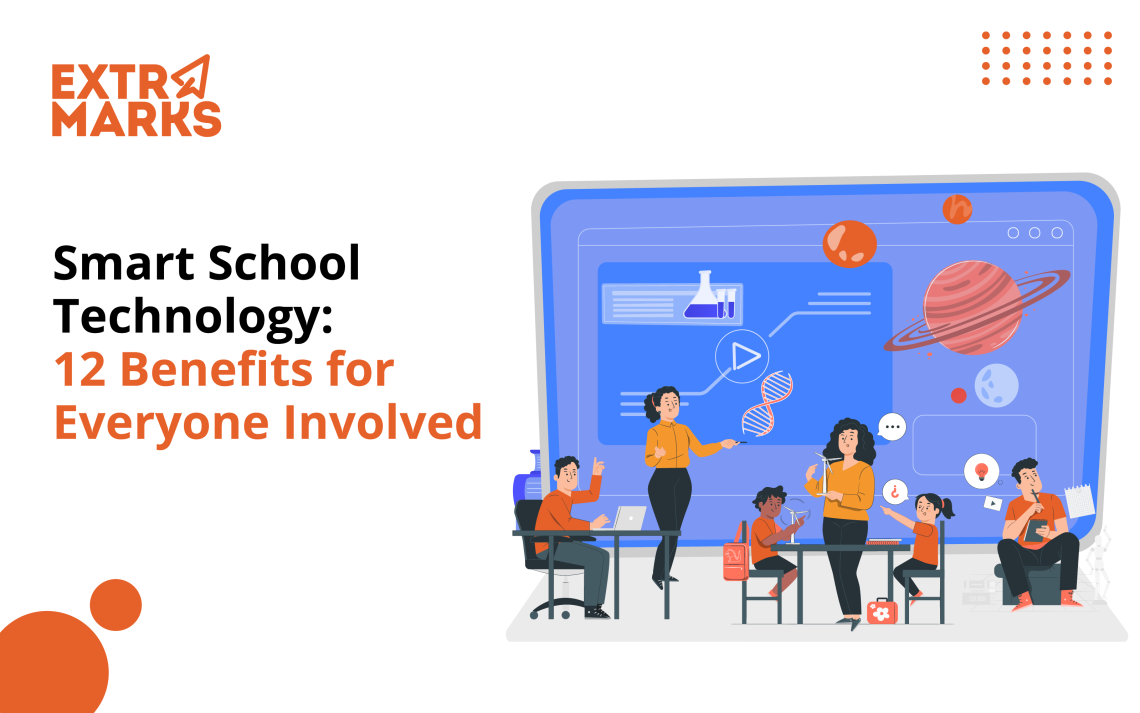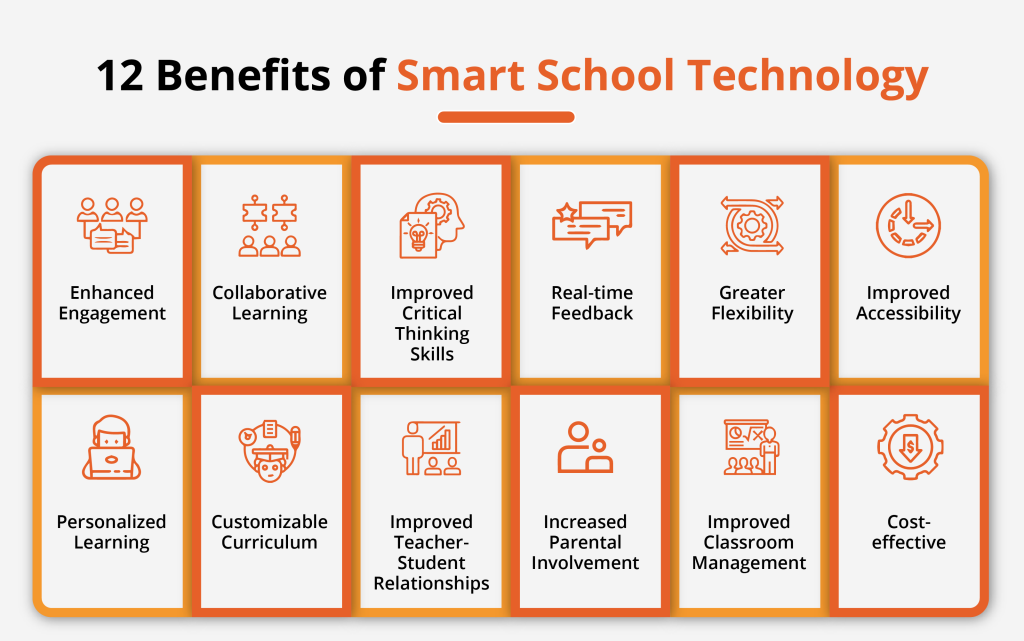12 Benefits Smart School Technology Offers to Students and Teachers

Today, technology is well integrated into every part of our daily lives. We use innumerable appliances to do our household chores, we carry our smartphones wherever we go and we can harness the power of the internet at the touch of a button. In the education sector, as well, technological advancements have transformed the traditional classroom into a more interactive and engaging learning environment. Smart school technology has revolutionized the way students learn, and it has made learning more accessible, fun, and effective.
The integration of smart school technology has brought about numerous benefits that have transformed the way students learn. Traditional teaching methods, which relied solely on textbooks and lectures, are being supplemented with innovative, interactive, and engaging tools and techniques that cater to the diverse learning styles of students.
Benefits of Smart School Technology

Smart school technology offers many impactful benefits that extend beyond the traditional classroom. With the integration of technology, the learning experience has become more personalized, engaging, and effective. Let us explore the various benefits of smart school technology and how it can help students maximize their learning potential and achieve their academic goals.
Benefit 1: Enhanced Engagement
Smart school technology has revolutionized the traditional classroom into an interactive and engaging learning environment. The integration of digital tools such as smart boards, tablets, and educational apps makes learning more engaging for students and helps teachers initeract with them better. By using interactive methods of learning, teachers can ensure that students are able to better comprehend the concepts being taught and that they are able to retain the topics. The use of modern technologies like 3D printing or virtual reality can offer students a more in-depth perspective into the topics they are learning and help them better visualize complex ideas.
Benefit 2: Improved Accessibility
Today, learning is more accessible than ever before. Online classes and virtual learning platforms have made education possible for students from all over the world, regardless of their geographic location or time zone. Technology lets students access high-quality education even if their physical location limits their options. It also allows students from poor socio-economic backgrounds access to learning materials they would not have otherwise been able to afford. This has also eliminated the constraints of time and distance, and other financial limitations, allowing students to learn uninhibited.
Benefit 3: Personalized Learning
Today’s teachers are able to personalize their teaching methods and cater to the individual needs of each student. Using platforms like Extramarks Smart School Plus, schools can offer each student assessments based on their individual learning needs basis their progress, capabilities and preferred learning style. What’s more, with the help of diagnostic assessments, teachers can identify learning gaps and determine what eac student’s strengths and weaknesses are, and what subjects they are having a tough time with. This allows them to provide personalized feedback and assignments to each student, helping them to improve.
Benefit 4: Collaborative Learning
Smart school technology has made it easier for students to collaborate with each other and work together on projects and assignments. With the help of digital tools, students can communicate with each other and collaborate on projects and assignments. By receiving feedback from their peers, competing with each other and learning from each other, students can stay motivated to continue offering their best performance.
Benefit 5: Improved Critical Thinking Skills
Smart school technology boosts critical thinking. While traditional teaching methods favoured memorization and solving long, written answers, modern smart school technology allows them to interact with topics in a way that has them solve problems based on real-world applications and use cases. It helps improve their critical thinking and problem-solving skills. Digital tools that help with this include simulations, virtual labs, and gamified assignments.
Benefit 6: Real-time Feedback
Receiving real-time feedback on their assignments and assessments is extremely beneficial for a student’s psyche as well as their growth. Platforms like Extramarks offer students instant automated feedback to let them fully understand their errors and ways in which they can improve. They also motivate students to do better and help them celebrate their improvements. Real-time feedback has also helped improve the overall quality of learning as well as saving teachers’ time in offering feedback to each individual student.
Benefit 7: Greater Flexibility
Smart school technology has made teaching and learning more flexible. Teachers can connect with their students, without being restricted to traditional classroom conversations. Even parents have the option to connect with and receive word of their child’s progress, whenever they want to do so, without having to worry about taking a trip to the school. Teachers don’t need to worry about printing or copying learning materials and can send them directly to their students.
Benefit 8: Improved Data Collection
Smart school technology can help generate a significant amount of classroom and student data. This data can be used to generate insights that help decision-makers and educators make more informed decisions when it comes to education. This is especially beneficial as it can help education evolve, which is the need of the hour in today’s ever-changing world. Schools constantly run the risk of becoming outdated or irrelevant. By generating data, education can continue to evolve, contributing to the improvement of curriculum, systems, and tools so that their students stay on top of modern advances.
Benefit 9: Improved Teacher-Student Relationships
Teacher-student relationships of the past were largely dependent on the additional time teachers gave to individual students as well as the student’s willingness to interact with their teachers. Smart school technology such as online chat and video conferencing has made it easier for teachers to communicate with their students, provide feedback, and offer support. This has led to a significant improvement in teacher-student relationships.
Benefit 10: Increased Parental Involvement
While its importance is often ignored, the proactive involvement of parents is vital to a student’s academic progress. Smart school technology has made it easier for parents to play a persistent role in their child’s education. With the help of online portals, parents can monitor their child’s progress, communicate with teachers, and access learning resources.
Benefit 11: Improved Classroom Management
The integration of smart school technology has changed how classrooms can be managed, fundamentally, enabling teachers to create a safe, inclusive, and productive learning environment for their students. With the help of digital tools and platforms like Extramarks Smart School Plus, teachers can manage their students’ attendance, keep track of their performance, and view all student information in one place. This caan help them efficiently manage their classrooms and focus on delivering quality education. Online attendance tracking allows teachers to easily record student attendance, monitor absenteeism, and promptly follow up with students who are absent. This technology has made attendance tracking much more efficient and reliable, reducing the burden on teachers and ensuring that students are accounted for. Furthermore, behavior management systems have provided teachers with a powerful tool to promote positive behaviour and discipline in the classroom. By setting clear expectations and guidelines, teachers can use these systems to track student behavior and provide feedback, as needed.
Benefit 12: Cost Effective
With the advent of digital tools and online resources, the need for expensive textbooks has decreased significantly. Instead, students can access a wealth of information and educational materials online, often at no cost. This has resulted in a substantial reduction in the overall cost of education, making it more affordable and accessible for students from all socio-economic backgrounds.
Moreover, the use of technology has also led to a significant reduction in the cost of infrastructure for educational institutions. Online learning platforms, virtual classrooms, and other digital tools have made it possible for schools to operate with fewer physical facilities, saving on the cost of building maintenance, utilities, and other associated expenses. As a result, technology has played a crucial role in democratizing education and creating more opportunities for students who may have previously been excluded from traditional educational models.
Smart school technology has fundamentally changed the way we approach education. Learning is now more accessible than ever. Teachers are able to eliminate mundane tasks like paper correction or attendance checks from their schedules and focus on actual teaching. It has also gone a long way in improving students’ educational experience making it more engaging, and thus effective in the long run. With Extramarks, schools can help their students maximize their learning potential and achieve academic success. Our SmartClass Plus platform puts an emphasis on personalized learning, interactive activities, real-time feedback, and much more. With Extramarks, students can learn at their own pace, access a variety of resources, and collaborate with other students. Sign up for smart school technology. Sign up for Extramarks.
Last Updated on April 16, 2025









